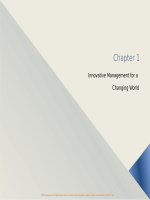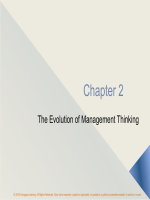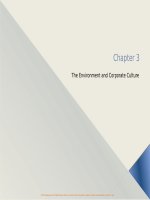Management 12e by w griffin ch12
Bạn đang xem bản rút gọn của tài liệu. Xem và tải ngay bản đầy đủ của tài liệu tại đây (812.89 KB, 24 trang )
TWELFTH EDITION
MANAGEMENT
Ricky W. Griffin
Part Four: The Organizing Process
Chapter Twelve: Managing Organization Change and Innovation
© 2017 Cengage Learning. All rights reserved. May not be copied, scanned, or duplicated, in whole or in part, except for use as permitted in a license distributed with a certain product or service or otherwise on a password-protected
website for classroom use.
12 - 1
Learning Outcomes
1.
2.
3.
4.
Describe the nature of organization change, including forces for change and
planned versus reactive change.
Discuss the steps in organization change and how to manage resistance to
change.
Identify and describe major areas of organization change and discuss the
assumptions, techniques, and effectiveness of organization development.
Describe the innovation process, forms of innovation, failure to innovate, and how
organizations can promote innovation.
© 2017 Cengage Learning. All rights reserved. May not be copied, scanned, or duplicated, in whole or in part, except for use as permitted in a license distributed with a certain product or service or otherwise on a password-protected
website for classroom use.
12 - 2
Nature of Organization Change
Organization change
Forces for change
– is any substantive modification to some part of the organization.
– External forces derive from the organization’s general and task environments.
– Internal forces (i.e. strategy) can cause change.
•
Other internal forces may be a reflection of external forces, such as sociocultural forces.
© 2017 Cengage Learning. All rights reserved. May not be copied, scanned, or duplicated, in whole or in part, except for use as permitted in a license distributed with a certain product or service or otherwise on a password-protected
website for classroom use.
12 - 3
Nature of Organization Change
Planned change
Reactive change
•
•
Designed and implemented in an orderly and
timely fashion in anticipation of future events.
A piecemeal response to circumstances as
they develop.
The frequency of organization change reinforces the importance of a planned approach.
© 2017 Cengage Learning. All rights reserved. May not be copied, scanned, or duplicated, in whole or in part, except for use as permitted in a license distributed with a certain product or service or otherwise on a password-protected
website for classroom use.
12 - 4
Managing Change in Organizations
Steps in the change process
– Kurt Lewin provides a model suggesting every change requires three steps:
•
•
•
The first step is unfreezing people affected by impending change.
Next, comes implementation of the change itself.
Finally, refreezing people involved by reinforcing and supporting the change.
– Lewin’s model lacks specificity, a more comprehensive model is needed.
© 2017 Cengage Learning. All rights reserved. May not be copied, scanned, or duplicated, in whole or in part, except for use as permitted in a license distributed with a certain product or service or otherwise on a password-protected
website for classroom use.
12 - 5
Managing Change in Organizations
This approach
to change takesapproach
a systems view and
Comprehensive
delineates a series of specific steps that often lead to
successful change.
© 2017 Cengage Learning. All rights reserved. May not be copied, scanned, or duplicated, in whole or in part, except for use as permitted in a license distributed with a certain product or service or otherwise on a password-protected
website for classroom use.
12 - 6
Figure 12.1
Steps in the Change Process
Managers must understand
how and why to implement
change.
© 2017 Cengage Learning. All rights reserved. May not be copied, scanned, or duplicated, in whole or in part, except for use as permitted in a license distributed with a certain product or service or otherwise on a password-protected
website for classroom use.
12 - 7
Understanding Resistance to Change
Uncertainty
Threatened selfinterests
Different perceptions
Feelings of loss
Managers need to know why people resist change and how to counter resistance.
© 2017 Cengage Learning. All rights reserved. May not be copied, scanned, or duplicated, in whole or in part, except for use as permitted in a license distributed with a certain product or service or otherwise on a password-protected
website for classroom use.
12 - 8
Overcoming Resistance to Change
Participation is often an effective technique.
Provide education and communication throughout the change process.
Facilitate the change process by:
– making only necessary changes,
– announcing those changes well in advance, and
– allowing time for people to adjust.
© 2017 Cengage Learning. All rights reserved. May not be copied, scanned, or duplicated, in whole or in part, except for use as permitted in a license distributed with a certain product or service or otherwise on a password-protected
website for classroom use.
12 - 9
Figure 12.2
Force-Field Analysis for Plant Closing at General Motors
Use this analysis to remove or at least minimize forces of resistance.
© 2017 Cengage Learning. All rights reserved. May not be copied, scanned, or duplicated, in whole or in part, except for use as permitted in a license distributed with a certain product or service or otherwise on a password-protected
website for classroom use.
12 - 10
Table 12.1
Areas of Organization Change
© 2017 Cengage Learning. All rights reserved. May not be copied, scanned, or duplicated, in whole or in part, except for use as permitted in a license distributed with a certain product or service or otherwise on a password-protected
website for classroom use.
12 - 11
Areas of Organization Change
Business process change or reengineering
– is a radical redesign of all aspects of a business to achieve major gains in cost,
service, or time.
– Goes beyond ERP.
The need for business process change
– allows managers to avoid entropy, or system-wide decline.
© 2017 Cengage Learning. All rights reserved. May not be copied, scanned, or duplicated, in whole or in part, except for use as permitted in a license distributed with a certain product or service or otherwise on a password-protected
website for classroom use.
12 - 12
Figure 12.3
The Reengineering
Process
Business process
reengineering has five
steps.
© 2017 Cengage Learning. All rights reserved. May not be copied, scanned, or duplicated, in whole or in part, except for use as permitted in a license distributed with a certain product or service or otherwise on a password-protected
website for classroom use.
12 - 13
Areas of Organization Change
Organization development (OD)
– is a planned, organization-wide effort, managed from the top, intended to increase
organizational effectiveness and health through planned interventions in the
organization’s process, using behavioral science knowledge.
– Based on the assumptions that:
•
•
•
employees desire to grow and develop,
they have a need for acceptance, and
organization design influences employee behavior.
© 2017 Cengage Learning. All rights reserved. May not be copied, scanned, or duplicated, in whole or in part, except for use as permitted in a license distributed with a certain product or service or otherwise on a password-protected
website for classroom use.
12 - 14
Organizational Development Techniques
Diagnostic activities.
Effectiveness varies.
Team building.
Survey feedback.
Education.
Intergroup activities.
Technostructural activities.
Process consultation.
Life and career planning.
Coaching and counseling.
Planning and goal setting.
Third-party peacemaking.
© 2017 Cengage Learning. All rights reserved. May not be copied, scanned, or duplicated, in whole or in part, except for use as permitted in a license distributed with a certain product or service or otherwise on a password-protected
website for classroom use.
12 - 15
Organizational Innovation
The managed effort of anInnovation
organization to develop new products or
services or new uses for existing products for services.
Without innovation, organizations fall behind competitors.
© 2017 Cengage Learning. All rights reserved. May not be copied, scanned, or duplicated, in whole or in part, except for use as permitted in a license distributed with a certain product or service or otherwise on a password-protected
website for classroom use.
12 - 16
Figure 12.4
The Innovation Process
© 2017 Cengage Learning. All rights reserved. May not be copied, scanned, or duplicated, in whole or in part, except for use as permitted in a license distributed with a certain product or service or otherwise on a password-protected
website for classroom use.
12 - 17
Forms of Innovation
•
Radical innovation
Incremental
Is a new product, service, or technology that
completely replaces an existing one.
•
Is a new product, service, or technology that
modifies an existing one.
innovation
Radical versus incremental innovations
© 2017 Cengage Learning. All rights reserved. May not be copied, scanned, or duplicated, in whole or in part, except for use as permitted in a license distributed with a certain product or service or otherwise on a password-protected
website for classroom use.
12 - 18
Forms of Innovation
Technical innovation
•
Managerial innovation
•
Is a change in the appearance or
Is a change in the management process
performance of products or services, or
by which products and services are
of the physical processes through which
conceived, built, and delivered to
a product or service passes.
customers.
Technical versus managerial innovations
© 2017 Cengage Learning. All rights reserved. May not be copied, scanned, or duplicated, in whole or in part, except for use as permitted in a license distributed with a certain product or service or otherwise on a password-protected
website for classroom use.
12 - 19
Forms of Innovation
Product innovation
•
Is a change in the physical characteristics or performance of existing products or services,
or the creation of new ones.
Process innovation
•
Is a change in the way products or services are manufactured, created, or distributed.
Product versus process innovations
© 2017 Cengage Learning. All rights reserved. May not be copied, scanned, or duplicated, in whole or in part, except for use as permitted in a license distributed with a certain product or service or otherwise on a password-protected
website for classroom use.
12 - 20
Figure 12.5
Effects of Product and Process Innovation on Economic
Return
© 2017 Cengage Learning. All rights reserved. May not be copied, scanned, or duplicated, in whole or in part, except for use as permitted in a license distributed with a certain product or service or otherwise on a password-protected
website for classroom use.
12 - 21
Failure to Innovate
If a firm lacks resources it may lag behind in innovation.
If an organization is unskilled in recognizing and evaluating opportunities,
they may fail to invest in an innovation.
Innovation means giving up old products, which means change.
– Many resist change, therefore, innovation.
© 2017 Cengage Learning. All rights reserved. May not be copied, scanned, or duplicated, in whole or in part, except for use as permitted in a license distributed with a certain product or service or otherwise on a password-protected
website for classroom use.
12 - 22
Promoting Innovation in Organizations
Provide financial and nonfinancial rewards.
Organization culture should support creative and innovative activities.
– Avoid punishing workers for innovation.
Intrapreneurs develop new businesses in the context of a large organization.
– Successful programs need someone to fill the roles of the inventor, a product
champion, and a sponsor.
© 2017 Cengage Learning. All rights reserved. May not be copied, scanned, or duplicated, in whole or in part, except for use as permitted in a license distributed with a certain product or service or otherwise on a password-protected
website for classroom use.
12 - 23
Summary
Chapter twelve examined the nature of organization change and identified
the basic issues of managing change.
Major areas of change were identified and described.
Organization development was examined.
– Including business process change.
The chapter concluded by discussing innovation as a vital form of change.
© 2017 Cengage Learning. All rights reserved. May not be copied, scanned, or duplicated, in whole or in part, except for use as permitted in a license distributed with a certain product or service or otherwise on a password-protected
website for classroom use.
12 - 24









